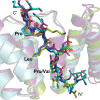Crystal structure of the Yersinia enterocolitica type III secretion chaperone SycD in complex with a peptide of the minor translocator YopD
- PMID: 22708907
- PMCID: PMC3443056
- DOI: 10.1186/1472-6807-12-13
Crystal structure of the Yersinia enterocolitica type III secretion chaperone SycD in complex with a peptide of the minor translocator YopD
Abstract
Background: Type III secretion systems are used by Gram-negative bacteria as "macromolecular syringes" to inject effector proteins into eukaryotic cells. Two hydrophobic proteins called translocators form the necessary pore in the host cell membrane. Both translocators depend on binding to a single chaperone in the bacterial cytoplasm to ensure their stability and efficient transport through the secretion needle. It was suggested that the conserved chaperones bind the more divergent translocators via a hexapeptide motif that is found in both translocators and conserved between species.
Results: We crystallized a synthetic decapeptide from the Yersinia enterocolitica minor type III secretion translocator YopD bound to its cognate chaperone SycD and determined the complex structure at 2.5 Å resolution. The structure of peptide-bound SycD is almost identical to that of apo SycD with an all helical fold consisting of three tetratricopeptide repeats (TPRs) and an additional C-terminal helix. Peptide-bound SycD formed a kinked head-to-head dimer that had previously been observed for the apo form of SycD. The homodimer interface comprises both helices of the first tetratricopeptide repeat. The YopD peptide bound in extended conformation into a mainly hydrophobic groove on the concave side of SycD. TPRs 1 and 2 of SycD form three hydrophobic pockets that accommodated the conserved hydrophobic residues at position 1, 3 and 6 of the translocator hexapeptide sequence. Two tyrosines that are highly conserved among translocator chaperones contribute to the hydrophobic patches but also form hydrogen bonds to the peptide backbone.
Conclusions: The interaction between SycD and YopD is very similar to the binding of the Pseudomonas minor translocator PopD to its chaperone PcrH and the Shigella major translocator IpaB to its chaperone IpgC. This confirms the prediction made by Kolbe and co-workers that a hexapeptide with hydrophobic residues at three positions is a conserved chaperone binding motif. Because the hydrophobic groove on the concave side of translocator chaperones is involved in binding of the major and the minor translocator, simultaneous binding of both translocators to a single type III secretion class II chaperone appears unlikely.
Figures



Similar articles
-
Structure of the Yersinia enterocolitica type III secretion translocator chaperone SycD.J Mol Biol. 2008 Jan 25;375(4):997-1012. doi: 10.1016/j.jmb.2007.11.009. Epub 2007 Nov 12. J Mol Biol. 2008. PMID: 18054956
-
Role of SycD, the chaperone of the Yersinia Yop translocators YopB and YopD.Mol Microbiol. 1999 Jan;31(1):143-56. doi: 10.1046/j.1365-2958.1999.01154.x. Mol Microbiol. 1999. PMID: 9987117
-
Evidence for alternative quaternary structure in a bacterial Type III secretion system chaperone.BMC Struct Biol. 2010 Jul 15;10:21. doi: 10.1186/1472-6807-10-21. BMC Struct Biol. 2010. PMID: 20633281 Free PMC article.
-
Structure and biophysics of type III secretion in bacteria.Biochemistry. 2013 Apr 16;52(15):2508-17. doi: 10.1021/bi400160a. Epub 2013 Apr 5. Biochemistry. 2013. PMID: 23521714 Free PMC article. Review.
-
Förster resonance energy transfer (FRET) as a tool for dissecting the molecular mechanisms for maturation of the Shigella type III secretion needle tip complex.Int J Mol Sci. 2012 Nov 16;13(11):15137-61. doi: 10.3390/ijms131115137. Int J Mol Sci. 2012. PMID: 23203116 Free PMC article. Review.
Cited by
-
A gatekeeper chaperone complex directs translocator secretion during type three secretion.PLoS Pathog. 2014 Nov 6;10(11):e1004498. doi: 10.1371/journal.ppat.1004498. eCollection 2014 Nov. PLoS Pathog. 2014. PMID: 25375170 Free PMC article.
-
Molecular Targets and Strategies for Inhibition of the Bacterial Type III Secretion System (T3SS); Inhibitors Directly Binding to T3SS Components.Biomolecules. 2021 Feb 19;11(2):316. doi: 10.3390/biom11020316. Biomolecules. 2021. PMID: 33669653 Free PMC article. Review.
-
Exploring the "N-Terminal Anchor" Binding Interface of the T3SS Chaperone-Translocator Complexes from P. aeruginosa.Biochemistry. 2023 Apr 18;62(8):1420-1427. doi: 10.1021/acs.biochem.3c00002. Epub 2023 Mar 30. Biochemistry. 2023. PMID: 36996474 Free PMC article.
-
The Deinococcus radiodurans DR1245 protein, a DdrB partner homologous to YbjN proteins and reminiscent of type III secretion system chaperones.PLoS One. 2013;8(2):e56558. doi: 10.1371/journal.pone.0056558. Epub 2013 Feb 18. PLoS One. 2013. PMID: 23441204 Free PMC article.
-
LcrH, a class II chaperone from the type three secretion system, has a highly flexible native structure.J Biol Chem. 2013 Feb 8;288(6):4048-55. doi: 10.1074/jbc.M112.395889. Epub 2012 Dec 11. J Biol Chem. 2013. PMID: 23233673 Free PMC article.
References
Publication types
MeSH terms
Substances
LinkOut - more resources
Full Text Sources

